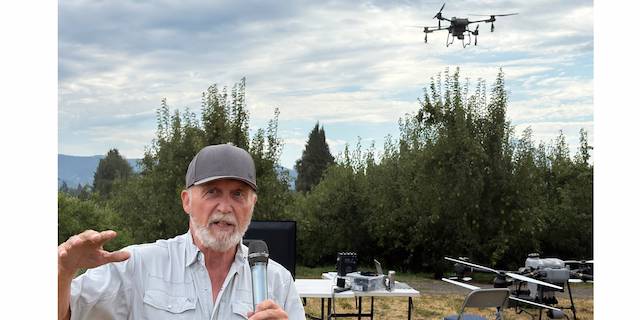Drones becoming more advanced for ag uses, but also more expensive
Published 7:00 am Friday, August 1, 2025

- Drone expert Mike Davis conducts a demonstration during a field day at Oregon State University’s Mid-Columbia Agricultural Research and Extension Center near Hood River on July 30. “These are tools to help you with precision ag,” Davis said. (Kyle Odegard/Capital Press)
HOOD RIVER — Drone expert Mike Davis said the devices were evolving at warp speed, becoming far more advanced and capable every growing season — but they’re also getting more expensive.
Sensors the drones can carry are more accurate in detecting pests, soil moisture variations, crop stress and livestock health, and the devices are incorporating artificial intelligence and algorithms.
“These are tools to help you with precision ag,” Davis said.
Trending
During a field day at Oregon State University’s Mid-Columbia Agricultural Research and Extension Center on July 30, Davis told farmers and researchers that drones could precisely spread seed or do sprays with specific rates and droplet sizes and targeted applications, saving farmers input and labor costs.
Drone sprays cover both above and below leaves, as the air force of their propellers is similar to helicopters and creates a sort of rebound effect.
Moments later, a drone buzzed about five to 10 feet above pear trees, followed a pre-defined path through the air and sprayed water on the orchard for a demonstration.
Davis is a professor of unmanned aircraft systems technology at Columbia Gorge Community College in The Dalles, Ore.
He also runs UAS Agriculture, which trains people to use drones in agriculture and helps them earn their Federal Aviation Administration remote pilot certification. The business holds online courses as well as training and classes at its 5,000 acre ranch in Tygh Valley, Ore.
Many drone issues are still being worked through, including how to spray pesticides over orchards, and Davis is part of FAA advisory groups.
Trending
Regulatory requirements are less difficult for smaller drones, but larger drones require certification and the process typically takes about a year.
Some drones are the size of small cars and cost as much as a diesel pickup. But the cost of using the devices can be attractive to agricultural operations because they can save money over time.
Drones also can get into challenging terrain in the Northwest that might be difficult for other farm machines.
Davis is a commercial multi-engine pilot for manned aircraft.
“I got into planes when I was 15 years old and I never got out. Aviation is in my blood. It’s the love of my life,” Daivs said.
He understood the commercial applications of drones early on and his interest evolved into that area of aviation.
Experts said residents generally aren’t aware of classes on piloting drones and many operators are self-taught.
Some people claim they have experience but don’t possess practical knowledge that classes and certification can provide, said Dave McCabe, a certified drone pilot and instructor with UAS Agriculture.
Davis said more standards, protocols and certifications will be necessary to grow confidence in commercial drone operations in the U.S.
Kalie Brunton, a fellow drone instructor at CGCC, said farm drone use is far more prevalent in the Midwest, where the landscape is flatter.
The next step will be highly trained drone pilots with crop expertise who can analyze sophisticated imaging, Brunton said.
CGCC’s drone program does contract work, and the Oregon Department of Fish and Wildlife hired it this year to reseed about 1,800 acres in Wasco County that had been burned in a wildfire.
CGCC is launching an Agricultural Technology program in Fall 2026 and officials hope to enroll about 30 students, said Tom Penberthy, director of marketing and communications.
Drone classes will be included under the AgTech umbrella, and Davis is on the committee designing the program’s curriculum.
Penberthy said the AgTech program will fit into CGCC’s growing trades-based offerings, including aviation maintenance technology, advanced manufacturing and fabrication, electro-mechanical technology and construction technology.








